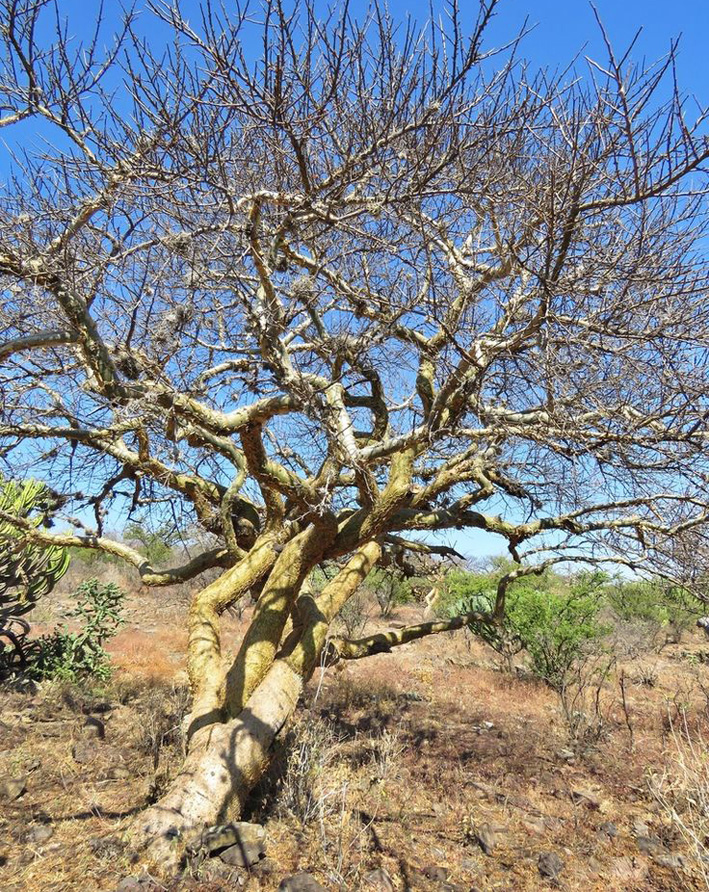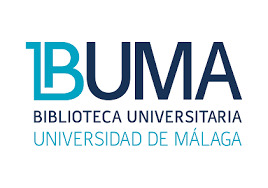Phytochemical evaluation of resin extracts of <i>Bursera fagaroides</i> (Kunth) Engl.
DOI:
https://doi.org/10.18387/polibotanica.60.19Keywords:
aromatic resin; phenolic acid; flavonoids; saponins; antioxidant activityAbstract
Bursera Jacq. ex L. (Burseraceae) are a group of deciduous trees and shrubs typical of tropical ecosystems, characterized by having exfoliating bark and producing resins that have multiple pharmacological properties that are used in traditional medicine. The objective was to perform a preliminary identification of the secondary metabolites present in the resin of Bursera fagaroides (Kunth) Engl. from the municipality of “Huehuetlan El Grande”, Puebla. A directed sampling was carried out where five trees of B. fagaroides were selected, from which a resin sample was taken. Hexane, dichloromethane and methanol extracts were obtained from the resin samples, where secondary metabolites were identified and quantified by colorimetric techniques and standard curves with reference molecules (gallic acid, quercetin, soybean saponin and masticadienoic acid). Similarly, the antioxidant activity of the dichloromethane and methanol extract was analyzed with the 2,2-diphenol-1-picrylhydrazyl (DPPH) method. The results indicate that the highest yield was obtained with the dichloromethane extract (870.32 mg/g resin) and secondary metabolites such as phenolic acids, flavonoids, saponins and terpenes were identified in the extracts. Terpenes showed the highest yield (638 mg/g of the dichloromethane extract) and the methanol extract presented the best antioxidant activity (26.2 % of DPPH inhibited and CIM50 = 6.1 mg/mL), besides alkaloids and tannins were not found. The results enrich the knowledge about the secondary metabolites that can be found and obtained from B. fagaroides resin. The resin of B. fagaroides from the municipality “Huehuetlan El Grande”, Puebla is a rich source of phenolic acids, flavonoids, saponins and terpenes, which can be explored in future medical and therapeutic research.
References
Antúnez-Mojica, M., Romero-Estrada, A., Hurtado-Díaz, I., Miranda-Molina, A., & Alvarez, L. (2021). Lignans from Bursera fagaroides: Chemistry, pharmacological effects and molecular mechanism. a current review. Life 11(7), 685. https://doi.org/10.3390/life11070685
Becerra, J. X., & Venable, D. L. (1999). Nuclear ribosomal DNA phylogeny and its implications for evolutionary trends in Mexican Bursera (Burseraceae). American Journal of Botany, 86(7), 1047-1057. https://doi.org/10.2307/2656622
Becerra, J. X., Venable, D. L., Evans, P. H., & Bowers, W. S. (2001). Interactions between chemical and mechanical defenses in the plant genus Bursera and their implications for herbivores. American Zoologist, 41(4), 865-876. https://doi.org/10.1093/icb/41.4.865
Becerra, J. X., Noge, K., Olivier, S., & Venable, D. L. (2012). The monophyly of Bursera and its impact for divergence times of Burseraceae. Taxon, 61(2), 333-343. https://doi.org/10.1002/tax.612005
Brand-Williams, W., Cuvelier, M. E., & Berset, C. (1995). Use of a free radical method to evaluate antioxidant activity. LWT-Food science and Technology, 28(1), 25-30. https://doi.org/10.1016/S0023-6438(95)80008-5
Castañeda-Miranda, A. G., Chaparro, M. A. E., Böhnel, H. N., Chaparro, M. A. E., Castañeda-Miranda, R., Pacheco-Castro, A., Martinez-Fierro, M. L., Solis-Sánchez, L. O., & Ornelas-Vargas, G. (2021). Bursera fagaroides bark as a bioindicator for air particle pollution using magnetic properties. Journal of South American Earth Sciences, 108, 103217. https://doi.org/10.1016/j.jsames.2021.103217
Columba-Palomares, M. C., Villarreal, M. L., Marquina, S., Romero-Estrada, A., Rodríguez-López, V., Alvarez, A. Z., & Alvarez, L. (2018). Antiproliferative and anti-inflammatory acyl glucosyl flavones from the leaves of Bursera copallifera. Journal of the Mexican Chemical Society, 62(4), 214-224. https://doi.org/10.29356/jmcs.v62i4.624
Daly, D. C. (1993). Notes on Bursera in South America, including a new species. Studies in Neotropical Burseraceae VII. Brittonia, 45, 240-246. https://doi.org/10.2307/2807109
García-Gutiérrez, H. A., Cerda-García-Rojas, C. M., Hernández-Hernández, J. D., Román-Marín, L. U., & Joseph-Nathan, P. (2008). Oxygenated verticillene derivatives from Bursera suntui. Phytochemistry, 69(16), 2844–2848. https://doi.org/10.1016/j.phytochem.2008.09.013
Gigliarelli, G., Becerra, J. X., Curini, M., Marcotullio, M. C., & Forti, L. (2015). Chemical composition and biological activities of fragrant mexican copal (Bursera spp.). Molecules, 20(12), 22383–22394. https://doi.org/10.3390/molecules201219849
Gordillo, J. C., Ortiz, D., Larrahondo, J. E., Mejía, M. S., & Pachon, H. (2012). Actividad antioxidante en guanábana (Annona muricata L.): una revisión bibliográfica. Boletin Latinoamericano y Del Caribe de Plantas Medicinales y Aromáticas, 11(2), 111-126. www.blacpma.usach.cl
Hernández, J. D., García, L., Hernández, A., Alvarez, R., & Román, L. U. (2002). Glicósidos de luteolina y miricetina de Burseraceae. In Revista de la Sociedad Química de México 46(4), 295-300.
Langenheim, J. H. (2003). Plant Resins: Chemistry, Evolution, Ecology, and Ethnobotany. Timber Press Portland Oregón, USA, 586.
Marcotullio, M. C., Curini, M., & Becerra, J. X. (2018). An ethnopharmacological, phytochemical and pharmacological review on lignans from Mexican Bursera spp. In Molecules 23(8), 1976. https://doi.org/10.3390/molecules23081976
Mojica, M. A., León, A., Rojas-Sepúlveda, A. M., Marquina, S., Mendieta-Serrano, M. A., Salas-Vidal, E., Villarreal, M. L., & Alvarez, L. (2016). Aryldihydronaphthalene-type lignans from Bursera fagaroides var. fagaroides and their antimitotic mechanism of action. RSC Advances, 6(6), 4950–4959. https://doi.org/10.1039/c5ra23516B
Montufar, A. L. (2004). Identidad y Simbolismo Del Copal Prehispánico y Reciente. Arqueología, 33, 60-71.
Morales-Serna, J. A., Cruz-Galicia, E., García-Ríos, E., Madrigal, D., Gaviño, R., Cárdenas, J., & Salmón, M. (2013). Three new diarylbutane lignans from the resin of Bursera fagaroides. Natural Product Research, 27(9), 824–829. https://doi.org/10.1080/14786419.2012.708658
Nakanishi, T., Inatomi, Y., Arai, S., Yamada, T., Fukatsu, H., Murata, H., Inada, A., Matsuura, N., Ubukata, M., Murata, J., Iinuma, M., Angel Perez Farrea, M., & Tanaka, T. (2003). New luteolin 3'-O-acylated rhamnosides from leaves of Bursera graveolens. Heterocycles, 60(9), 2077-2083. https://doi.org/10.1248/yakushi.127.1975
Noge, K., & Becerra, J. X. (2009). Germacrene D, A common sesquiterpene in the genus Bursera (Burseraceae). Molecules, 14(12), 5289–5297. https://doi.org/10.3390/molecules14125289
Oliveira, T. L. S., de Siqueira, L. K. C., de Macêdo, I. Y. L., de Morais, S. R., Costa, E. A., de Paula, J. R., & de Souza G. E. (2017). Electrochemical behavior and antioxidant activity of hibalactone. International Journal of Electrochemical Science, 12(9), 7956–7964. https://doi.org/10.20964/2017.09.54
Puebla-Pérez, A., Huacuja-Ruiz, L., Rodríguez-Orozco, G., Martha Villaseñor-García, M., De La Luz Miranda-Beltrán, M., Celis, A., & Sandoval-Ramírez, L. (1998). Cytotoxic and Antitumour Activity from Bursera fagaroides ethanol extract in mice with L5178Y Lymphoma. Phytotherapy Research: An International Journal Devoted to Pharmacological and Toxicological Evaluation of Natural Product Derivatives, 12(8), 545-548. https://doi.org/10.1002/(SICI)1099-1573(199812)12:8<545:AID-PTR349>3.0.CO;2-S
Rico, Y., Lorenzana, G. P., Benítez-Pineda, C. A., & Olukolu, B. A. (2022). Development of genomic resources in Mexican Bursera (Section: Bullockia: Burseraceae): genome assembly, annotation, and marker discovery for three copal species. Genes, 13(10), 1741. https://doi.org/10.3390/genes13101741
Rojas-Sepúlveda, A. M., Mendieta-Serrano, M., Mojica, M. Y. A., Salas-Vidal, E., Marquina, S., Villarreal, M. L., Puebla, A. M., Delgado, J. I., & Alvarez, L. (2012). Cytotoxic podophyllotoxin type-lignans from the steam bark of Bursera fagaroides var. fagaroides. Molecules, 17(8), 9506–9519. https://doi.org/10.3390/molecules17089506
Romero-Estrada, A., Maldonado-Magaña, A., González-Christen, J., Bahena, S. M., Garduño-Ramírez, M. L., Rodríguez-López, V., & Alvarez, L. (2016). Anti-inflammatory and antioxidative effects of six pentacyclic triterpenes isolated from the Mexican copal resin of Bursera copallifera. BMC Complementary and Alternative Medicine, 16(1). https://doi.org/10.1186/s12906-016-1397-1
Rosas-Arreguín, P., Arteaga-Nieto, P., Reynoso-Orozco, R., Villagómez-Castro, J. C., Sabanero-López, M., Puebla-Pérez, A. M., & Calvo-Méndez, C. (2008). Bursera fagaroides, effect of an ethanolic extract on ornithine decarboxylase (ODC) activity in vitro and on the growth of Entamoeba histolytica. Experimental Parasitology, 119(3), 398–402. https://doi.org/10.1016/j.exppara.2008.04.003
Rzedowski, J. & Kruse H. (1979). Algunas tendencias evolutivas en Bursera (Burseraceae). Taxon, 28(1/3),103-116. https://doi.org/10.2307/1219565
Rzedowski, J., Lemos, R. M., & de Rzedowski, G. C. (2005). Inventario del conocimiento taxonómico, así como de la diversidad y del endemismo regionales de las especies mexicanas de Bursera (Burseraceae). Acta Botánica Mexicana, 70, 85-111. https://doi.org/10.21829/abm70.2005.989
Sánchez-Monroy, M. B., García-Bores, D. M., Contreras-Jiménez, J. L., Torres, D. E., San Miguel-Chávez, R., & Guevara-Fefer, P. (2020). Biological activity and flavonoid profile of five species of the Bursera genus. Botanical Sciences, 98(4), 545–553. https://doi.org/10.17129/botsci.2624
Souza, M. P., Iracema, M., Machado, L., & Braz-Filho, R. (1989). Six flavonoids from Bursera leptophloeos. Phytochemistry, 28 (9), 2467-2470. https://doi.org/10.1016/S0031-9422(00)98007-5
Vidal Gutiérrez, M., Torres Moreno, H., Arturo Velázquez Contreras, C., Alondra, L., Valenzuela, R., Enrique, R., & Zepeda, R. (2020a). Actividad antioxidante y antiproliferativa de seis plantas medicinales del noroeste de México. Biotecnia, 22(3), 40-45. http://biotecnia.unison.mx
Vidal-Gutiérrez, M., Robles-Zepeda, R. E., Vilegas, W., Gonzalez-Aguilar, G. A., Torres-Moreno, H., & López-Romero, J. C. (2020b). Phenolic composition and antioxidant activity of Bursera microphylla A. Gray. Industrial Crops and Products, 152, 112412. https://doi.org/10.1016/j.indcrop.2020.112412
Yadav, R., & Agarwala, M. (2011). Phytochemical analysis of some medicinal plants. Journal of Phytology, 3(12), 10–14. http://journal-phytology.com/

Downloads
Published
License
Copyright (c) 2025 POLIBOTANICA

This work is licensed under a Creative Commons Attribution-NonCommercial-ShareAlike 4.0 International License.

Polibotánica by Departamento de Botánica de la Escuela Nacional de Ciencias Biológicas del Instituto Politécnico Nacional se distribuye bajo una Licencia Creative Commons Atribución-NoComercial-CompartirIgual 4.0 Internacional.



















